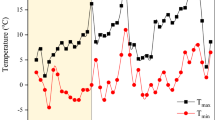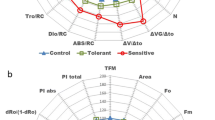Abstract
The cold stress effect on early vigour and photosynthesis efficiency was evaluated for five industrial chicory varieties with contrasting early vigour. The relationships between the growth and physiological parameters were assessed. The varieties were examined at three growth temperatures: 16 (reference), 8 (intermediate) and 4 °C (stress). The effect was measured using physiological processes (growth, photosynthesis, chlorophyll a fluorescence), and pigment content. The analysis of the measured growth parameters (dry leaf and root mass, and leaf area) indicated that temperature had a significant effect on the varieties, but the overall reaction of the varieties was similar with lowering temperatures. The photosynthesis and chlorophyll a fluorescence measurements revealed significant changes for the photosynthesis (maximum net photosynthesis, quantum efficiency, light compensation point and dark respiration) and chlorophyll a fluorescence parameters (photochemical and non-photochemical quenching) with lowering temperatures for Hera and Eva, two extremes in youth growth. No significant differences could be found between the extremes for the different temperatures. The pigment content analysis revealed significant differences at 4 °C in contrast to 16 and 8 °C, especially for the xanthophyll/carotenoid pool, suggesting a protective role. Subsequently, the relationship between the physiological processes was evaluated using principal component analysis. At 4 °C, 2 principal components were detected with high discriminating power for the varieties and similar classification of the varieties as determined in the growth analysis. This provides a preview on the possible relationships between photosynthesis and growth for industrial chicory at low temperatures.
Similar content being viewed by others
Abbreviations
- AGR:
-
average growth rate
- Cab :
-
total chlorophyll content
- Ca/Cb :
-
chlorophyll a/b ratio
- Cab/Cx+c :
-
chlorophyll/carotenoid-xanthophyll pool ratio
- Chl:
-
chlorophyll
- DM:
-
dry mass
- DML :
-
dry mass leaves
- DMR :
-
dry mass roots
- DMF:
-
N,N-dimethylformamid
- F′m :
-
maximum chlorophyll fluorescence yield in the light-adapted state
- Fs :
-
steady-state chlorophyll fluorescence yield level
- F′o :
-
minimum chlorophyll fluorescence yield in the light-adapted state
- Fv :
-
maximum variable chlorophyll fluorescence yield in the dark-adapted state
- F′v :
-
maximum variable chlorophyll fluorescence yield in the light-adapted state
- Ic :
-
light compensation point
- LA:
-
leaf area
- NPQ:
-
non-photochemical quenching
- PC:
-
principal component
- PCA:
-
principal component analysis
- P max :
-
maximum net photosynthesis
- P N :
-
net photosynthesis
- PSII:
-
photosystem II
- qN :
-
nonphotochemical quenching coefficient
- qP :
-
photochemical quenching
- R D :
-
dark respiration
- RGR:
-
relative growth rate
- SD:
-
standard deviation
- SLA:
-
specific leaf area
- x+c:
-
xanthophyll and carotenoid pool
- αc :
-
quantum efficiency
- ΦPSII :
-
quantum yield of photosystem II
References
Alves, P.L.C.A., Magalhães, A.C.N., Barja, P.R.: The phenomenon of photoinhibition of photosynthesis and its importance in reforestation. — Bot. Rev. 68: 193–208, 2002.
Baert, J.: The effect of sowing and harvest date and cultivar on inulin yield and composition of chicory roots — Ind. Crop Production 6: 195–199, 1997.
Baker, N.R., Rosenqvist, E.: Applications of chlorophyll fluorescence can improve crop production strategies: an examination of future possibilities. — J of Exp Bot 55: 1607–1621, 2004.
Brüggeman, W., van der Kooij, T.A.W., van Hasselt, P.R.: Long-term chilling of young tomato plants under low light and subsequent recovery. II. Chlorophyll fluorescence, carbon metabolisn and activity of ribulose-1,5-bisphosphate carboxylase/oxygenase. — Planta 186: 179–187, 1992.
Close, D.C., Beadle, C.L.: The ecophysiology of foliar anthocyanin. — Bot. Rev 69: 149–161, 2003.
Devacht, S., Lootens, P., Carlier, L., Baert, J., Van Waes, J., Van Bockstaele, E.: Effect of cold stress on early vigour, photosynthesis, chlorophyll a fluorescence and pigment content of industrial chicory. — Comm. Agr. Appl. Biol. Sci. 72: 165–169, 2007.
Dogniaux, R., Lemoine, M., Sneyers, R.: Année-type moyenne pour le traitement de problèmes de capitation d’énergie solaire. — Royal Meteorological Institute of Belgium, Brussels 1978.
Ensminger, I., Busch, F., Huner, N.P.A.: Photostasis and cold acclimation: sensing low temperature through photosynthesis. — Physiol. Plant. 126: 28–44, 2006.
Fracheboud, Y., Haldimann, P., Leipner, J., Stamp, P.: Chlorophyll fluorescence as a selection tool for cold tolerance of photosynthesis in maize (Zea mays L.). — J. Exp. Bot. 50: 1533–1540, 1999.
Fracheboud, Y., Ianelli, M.A., Pietrini, F., Massaci, A.: Photoprotection in maize at suboptimal temperatures. — Proc COST Action 814: 115–120, 2000.
Fracheboud, Y., Leipner, J.: The application of chlorophyll fluorescence to study light, temperature and drought stress. — In: DeEll, J.R., Toivonen, P.M.A. (ed.): Practical Applications of Chlorophyll Fluorescence in Plant Biology. Pp. 125–150. Kluwer Acad. Publishers, Norwell 2003.
Gitelson, A.A., Merzlyak, M.N., Chivkunova, O.B.: Optical properties and non-destructive estimation of anthocyanin content in plant leaves. — Photochem. Photobiol. 74: 38–45, 2001.
Gonzalez, J.A., Liberman-Cruz, M., Boero, C., Gallardo, M., Prado, F.E.: Leaf thickness, protective and photosynthetic pigments and carbohydrate content in leaves of the world’s highest elevation tree Polylepis tarapacana (Rosaceae). — Phyton: 41–53, 2002.
Haldimann, P.: Chilling-induced changes to carotenoid composition, photosynthesis and the maximum quantum yield of photosystem II photochemistry in two maize genotypes differing in tolerance to low temperature. — J. Plant Physiol. 151: 610–619, 1997.
Haldimann, P.: Low growth temperature-induced changes to pigment composition and photosynthesis in Zea mays genotypes differing in chilling sensitivity. — Plant Cell Environ. 21: 200–208, 1998.
Haldimann, P.: How do changes in temperature during growth affect leaf pigment composition and photosynthesis in Zea mays genotypes differing in sensitivity to low temperature? — J. Exp. Bot. 50: 543–550, 1999.
Holton, T.A., Cornish, E.C.: Genetics and biochemistry of anthocyanin biosynthesis. — The Plant Cell 7: 1071–1083, 1995.
Hunt, R.: Concepts in plant growth analysis. — In: Hunt, R. (ed.): Plant Growth Curves: The Functional Approach to Plant Growth Analysis. Pp. 14–46. Edward Arnold, London 1982.
Janda, T.: Use of chlorophyll fluorescence induction techniques in the study of low temperature stress in plants. — Acta Agron. Hungarica 46: 77–91, 1998.
Koroleva, O.Y., Brüggeman, W., Krause, G.H.: Photoinhibition, xanthophyll cycle and in vivo chlorophyll fluorescence quenching of chilling-tolerant Oxyria digyna and chillingsensitive Zea mays. — Physiol Plant 92: 577–584, 1994.
Lidon, F.C., Loureiro, A.S., Vieira, D.E., Bilhó, E.A., Nobre, P., Costa, R.: Photoinhibition in chilling stressed wheat and maize. — Photosynthetica 39: 161–166, 2001.
Long, S.P., Zhu, X.G., Naidu, S.L., Ort, D.R.: Can improvement in photosynthesis increase crop yields? — Plant Cell Environ. 29: 315–330, 2006.
Lootens, P., Van Waes, J., Carlier, L.: Effect of a short photoinhibition stress on photosynthesis, chlorophyll a fluorescence and pigment contents of different maize cultivars. Can a rapid and objective stress indicator be found? — Photosynthetica 42: 187–192, 2004.
Maxwell, K., Johnson, G.N.: Chlorophyll fluorescence — a practical guide. — J. Exp. Bot. 51: 659–668, 2000.
Niyogi, K.K., Björkman, O., Grossman, A.R.: Chlamydomonas xanthophylls cycle mutants identified by video imaging of chlorophyll fluorescence quenching. — The Plant Cell 9: 1369–1380, 1997a.
Niyogi, K.K., Björkman, O., Grossman, A.R.: The roles of specific xanthophylls in photoprotection. — PNAS 94, 14162–14167, 1997b.
Oliveira, G., Peñuelas, J.: Effects of winter cold stress on photosynthesis and photochemical efficiency of PSII of the Mediterranean Cistus albidus L. and Quercus ilex L. — Plant Ecol. 175: 179–191, 2004.
Osmond, C.B.: What is photoinhibition? Some insights from comparison of shade and sun plants. — In: Baker, N.R., Bowyer, J.R. (ed.): Photoinhibition of Photosynthesis: from Molecular Mechanisms to the Field. Pp. 1–24. Bios Scientific Publ., Oxford 1994.
Roháček, K.: Chlorophyll fluorescence parameters: the definitions, photosynthetic meaning, and mutual relationships. — Photosynthetica 40: 13–29, 2002.
Richter, M., Rühle, W., Wild, A.: Studies on the mechanisms of photosystem II photoinhibition, 1. A 2-step degradation of D1-protein. — Photosynth. Res 24: 229–235, 1990.
Schurr, U., Walter, A., Rascher, U.: Functional dynamics of plant growth and photosynthesis — from-steady state to dynamics — from homogeneity to heterogeneity. — Plant Cell Environ. 29: 340–352, 2006.
Taiz, L., Zeiger, E.: Photosynthesis: the light reactions. — In: Taiz, L., Zeiger, E (ed.): Plant Physiology. Pp. 111–143. Sinauer Associates Inc. Publishers, Sunderland 2002.
Venema, J.H., Eekhof, M., Van Hasselt, P.R.: Analysis of lowtemperature tolerance of a tomato (Lycopersicon esculentum) cybrid with chloroplasts from a more chilling-tolerant L. hirsutum accession. — Ann. Bot. 85: 799–807, 2000.
Verheul, M.J., Picatto, C., Stamp, P.: Growth and development of maize (Zea mays L.) seedlings under chilling conditions in the field. — Eur. J. Agron 5: 31–43, 1996.
Wellburn, A.R.: The spectral determination of chlorophyll a and chlorophyll b, as well as total carotenoids, using various solvents with spectrophotometers of different resolution. — J. Plant Physiol. 144: 307–313, 1994.
Wolfe, D.W.: Low temperature effects on early vegetative growth, leaf gas exchange and water potential of chillingsensitive and chilling-tolerant crop species. — Ann. Bot. 67: 205–212, 1991.
Author information
Authors and Affiliations
Corresponding author
Additional information
Acknowledgements: The authors thank Laurent Gevaert, Luc Van Gijseghem and Christian Hendrickx for the help with the measurements, cultivation and maintenance of the plants.
Rights and permissions
About this article
Cite this article
Devacht, S., Lootens, P., Roldán-Ruiz, I. et al. Influence of low temperatures on the growth and photosynthetic activity of industrial chicory, Cichorium intybus L. partim. Photosynthetica 47, 372–380 (2009). https://doi.org/10.1007/s11099-009-0058-8
Received:
Accepted:
Published:
Issue Date:
DOI: https://doi.org/10.1007/s11099-009-0058-8




